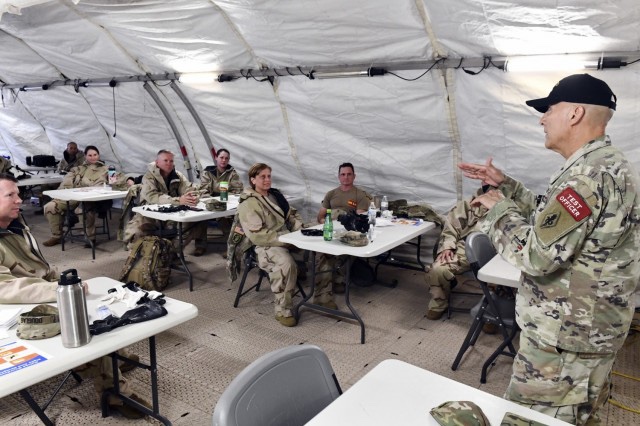JOINT BASE SAN ANTONIO, TX – The U.S. Army Medical Test and Evaluation Activity (USAMTEAC) conducted a customer test for the Rapid Opioid Countermeasure System (ROCS) auto-injector at the Deployable Medical System Equipment for Training (DMSET) site in Camp Bullis, TX. USAMTEAC, formally called the Army Medical Department Board (USAMEDDBD), is part of the U.S. Army Medical Center of Excellence (MEDCoE), and provides independent operational testing and evaluation of medical and medical-related materiel and information technology products in support of the Army`s Department of Defense acquisition processes.

The ROCS test was requested by the product manager at the Joint Program Executive Office for Chemical Biological Defense (JPEO–CBD), Medical Countermeasures Systems (MCS) to assess the functionality and usability of the ROCS auto-injector within the operational environment. Soldiers who are the typical users of the ROCS served as test players for the event. The ROCS auto-injector report is relevant and provides JPEO–CBD MCS a report and data for their evaluation and possible future fielding throughout the Army.

Army test players participated in self-aid and buddy-aid scenarios using the ROCS, a single-use auto-injector pre-filled with 10 mg of Naloxone. The ROCS auto-injector provides the capability to deliver an intramuscular injection with a 22-gauge needle and be used in a suspected opioid environment with Soldiers wearing Mission Oriented Protective Posture (MOPP) Level 4 protective gear. During the test at Camp Bullis, test players also donned MOPP Level 4 gear in a simulated field environment.

“With the humanitarian missions we’re supporting our Soldiers may walk into a hot spot and unknowingly get exposed. The ROCS auto-injector will help if they are experiencing symptoms of opioid exposure with better medical care for the front line troops,” said Charles Lohsandt, one of the USAMTEAC Test Officers. “It’s a very small single-use cartridge that can easily fit in a gas mask carrier or inside one of the protective suit pockets, for example.”

Col. Mark Plooster, Executive Director, USAMTEAC, discussed the collaboration with other organizations in conducting this test. “What we do is bring in a capability developer from CDID (Army Futures Command Capability Development Integration Directorate), people from the FFID (Field Force Integration Directorate), the MRDC (U.S. Army Medical Research and Development Command), and Weapons of Mass Destruction – Civil Support Teams to bring in the whole team to make sure that everybody who has a piece of the pie is involved,” said Plooster. “At the end of the day the real customer is the Soldier on the battlefield. We try to make this test as realistic as we can using Soldiers in the actual unit that will be using the equipment.”

“The test players are the most important and valuable part of the test,” said Col. Roberto Marin, Chief, Materiel Test and Evaluation Branch, USAMTEAC. “Although we have the capability developers, the material developers, and us, the USAMTEAC test team, as the lead test agency, test players, also known as the end users, they provide us with honest feedback that is required to provide better medical care for the warfighter, the ultimate customer.” Said Marin. “Test player data feedback includes an after action review detailing the ROCS auto-injector strengths and weaknesses, a survey, and recommendations. We analyze all the data points and send a report to the material developer for higher level decision authority.”
To learn more about the USAMTEAC mission, visit their website at medcoe.army.mil/usamteac.
By Jose E. Rodriguez, MEDCoE Public Affairs


As a leo, I’ve seen my fair share of od’s from opiates over the years but once Fentanyl hit the scene it has gotten out of control – not just with the od’s but the potential effects of exposure.
This is a difficult subject. Fentanyl exposure potential is there, but not really as high as it’s been pumped to be. People don’t flail wildly when exposed to opioids, they’ll shut down almost completely ( respiratory depression/arrest, loss of consciousness, bradycardia, hypotension…) – I have seen probably the same exposure videos you have, and I’ve just seen guys scared to death they’re going to die. Is it something you should be careful about – yep, keep it away from your eyes, airway, and mouth, wear gloves in case it’s something else…. Notice I’m not saying it doesn’t exist like some docs will, but be sure that’s what you’re dealing with before Narcan- it’s not a benign drug( pulmonary edema, pneumonia……) .
Fentanyl as a threat isn’t limited to accidental exposure. I could see a terrorist organization whipping something like this up. https://en.m.wikipedia.org/wiki/Moscow_hostage_crisis_chemical_agent
Fairly easy to mix it with a carrier and atomize it. Not familiar with the exact method they used in Moscow, but IIRC it was a mixture including succinylcholine and isoflourane( saw a guy use Iso to clean a dry erase board once , hope to God it was a prank for students)